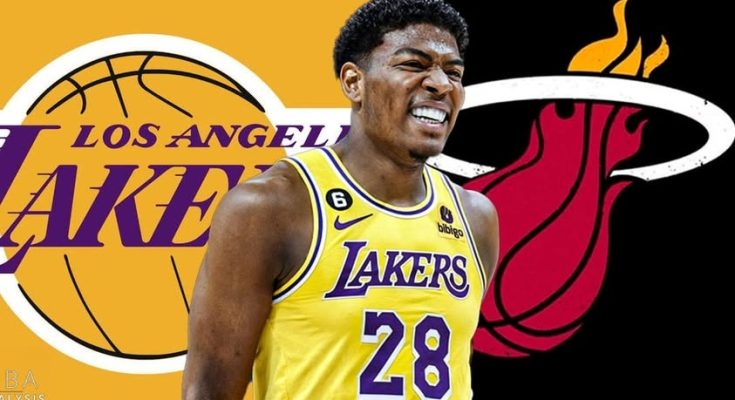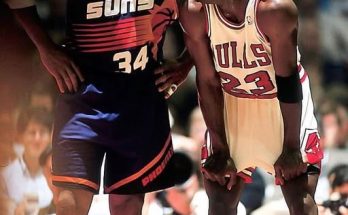The NBA landscape has once again been jolted by a bold and unexpected move as the Los Angeles Lakers have traded forward Rui Hachimura to the Miami Heat. This blockbuster deal marks a significant shift for both franchises and sets the stage for intriguing developments in the upcoming season. In an era where team chemistry, salary cap management, and long-term strategic planning intertwine, this trade is emblematic of the dynamic nature of modern NBA roster construction. Let’s break down the implications, motivations, and potential outcomes of this trade, and what it means for the Lakers, the Heat, and the league at large.
Rui Hachimura, a versatile forward known for his athleticism, scoring ability, and defensive potential, was acquired by the Lakers with hopes of adding depth and versatility to their frontcourt. However, the Lakers have opted to move him in what appears to be a strategic decision to recalibrate their roster and cap situation. For the Heat, acquiring Hachimura signals a commitment to bolstering their wing rotation with a player who fits their tough, defense-first culture while also offering offensive upside.
From the Lakers’ perspective, this trade aligns with a broader vision of flexibility and readiness to adapt. Los Angeles has faced ongoing challenges blending their star power with a complementary supporting cast. Although Hachimura showed flashes of promise, the Lakers’ front office seems intent on restructuring the team around different personnel or clearing cap space to pursue other key targets. The timing of the trade suggests that the Lakers are not content with maintaining the status quo and are actively seeking to refine their roster to better contend in a fiercely competitive Western Conference.
Meanwhile, the Miami Heat continue to build on their reputation as a franchise that maximizes value from savvy acquisitions. Hachimura’s arrival in Miami provides the Heat with a multi-dimensional player who can slide into multiple roles. His ability to defend several positions, shoot from mid-range and beyond, and finish at the rim complements the Heat’s emphasis on versatility and relentless effort. Furthermore, Hachimura’s youth and room to grow fit the Heat’s model of developing players within their system and culture, which has proven successful with other talents in recent years.
The trade’s ripple effects extend beyond the immediate player swap. For the Lakers, moving Hachimura could free up financial flexibility, potentially creating cap room to pursue marquee free agents or absorb another team’s contract in future trades. It also signals to the rest of the league that the Lakers are willing to make tough decisions, even involving promising young players, to accelerate their championship aspirations. This move might be a precursor to further roster changes, underscoring a front office mindset focused on optimizing every asset.
On the Heat’s side, the acquisition of Hachimura adds to a roster already rich with talent and experience, including players like Jimmy Butler, Bam Adebayo, and Tyler Herro. The Heat have long been a formidable team known for their defensive rigor and disciplined offense. Adding Hachimura expands their lineup options, enabling head coach Erik Spoelstra to experiment with different lineups that can adapt to varied opponents. The trade could also alleviate some of the offensive burden on existing stars, allowing the Heat to play a more balanced and unpredictable style.
This trade reflects broader NBA trends where teams emphasize versatility, youth, and salary cap management more than ever before. The modern NBA values players who can switch defensively, shoot efficiently from multiple spots, and contribute across the board. Hachimura’s skill set fits neatly into this mold, making him an attractive asset for the Heat. Conversely, the Lakers’ decision to trade him may highlight the premium they place on acquiring established stars or cap flexibility, perhaps indicating plans to pursue blockbuster deals or sign impactful free agents.
Fans and analysts alike are dissecting the potential on-court impact of this trade. Hachimura’s fit with the Heat could unlock new dimensions in Miami’s attack. His ability to create off the dribble, stretch the floor, and defend multiple positions allows Spoelstra to deploy creative tactics. If Hachimura thrives in Miami’s system, it could elevate the Heat’s standing as a championship contender in the Eastern Conference, particularly against powerhouse teams like the Milwaukee Bucks and Boston Celtics.
For the Lakers, the trade invites speculation about their next moves. Will they target a high-profile free agent or pursue another trade to bolster their roster? Are they signaling a shift towards a younger rebuild, or doubling down on veteran talent? The trade underscores the front office’s willingness to pivot quickly, a necessary approach in the fast-moving NBA environment. It also puts a spotlight on other Lakers players whose roles might change as the team seeks to maximize chemistry and effectiveness.
The emotional and cultural aspects of this trade also bear consideration. Hachimura, who has steadily developed since entering the league, faces a new chapter in Miami, a city known for its passionate fans and intense playoff atmosphere. Transitioning to the Heat’s system and culture could be a defining moment in his career, providing an opportunity to flourish under a coach known for maximizing player strengths. Meanwhile, Lakers fans will be watching closely, hoping this move leads to tangible success rather than disrupting team cohesion.
This trade also highlights the constant balance teams must strike between potential and proven results. Hachimura represents a player with promise and room to grow but has yet to fully realize his ceiling. The Lakers’ decision to part ways with him reflects their urgency to compete now, favoring players who can make immediate impacts. On the other hand, the Heat’s acquisition reflects their confidence in their developmental process and culture to help Hachimura reach his next level.
Financially, this trade has implications for both teams’ salary cap management. The Lakers might gain some breathing room to maneuver in free agency or to absorb other players in future trades. Miami takes on Hachimura’s contract, but within a system that values cost-efficient moves and maximizes each player’s output. The Heat’s front office is known for meticulous cap strategy, and this move fits within their blueprint of balancing talent acquisition with fiscal prudence.
The timing of this trade also matters. With the NBA offseason progressing and free agency approaching, teams are jockeying for position to assemble the best possible rosters. The Lakers’ willingness to move Hachimura at this juncture may be a strategic step to make room for other acquisitions or to send a message about their competitive priorities. For the Heat, landing Hachimura now means they can integrate him into offseason workouts and training camps, increasing the likelihood of a smooth transition.
This deal is likely to reverberate through league circles as other teams watch and assess how the trade impacts the balance of power. The Lakers and Heat are both franchises with championship pedigrees and high expectations, so any roster change involving them attracts significant attention. Depending on how Hachimura performs in Miami and how the Lakers respond in the coming weeks, this trade could shape narratives around team building, player development, and championship strategy.
Looking forward, all eyes will be on Rui Hachimura’s performance in Miami and how quickly he adapts to his new surroundings. Will he emerge as a key contributor on a deep Heat roster? Can the Lakers leverage the assets gained from this trade to make a significant splash in free agency or further trades? The answers will unfold over the coming season, providing insight into the efficacy of this bold roster move.
In conclusion, the trade sending Rui Hachimura from the Los Angeles Lakers to the Miami Heat represents a calculated and strategic decision by both organizations. It underscores the Lakers’ focus on flexibility and immediate impact, while highlighting the Heat’s commitment to versatile, developing talent. This move not only shifts the rosters of two prominent NBA franchises but also serves as a case study in modern NBA team-building philosophy — where adaptability, culture fit, and cap management are as critical as raw talent. As the NBA season approaches, this trade will be a key storyline, reflecting the ever-evolving chess match that defines professional basketball.



